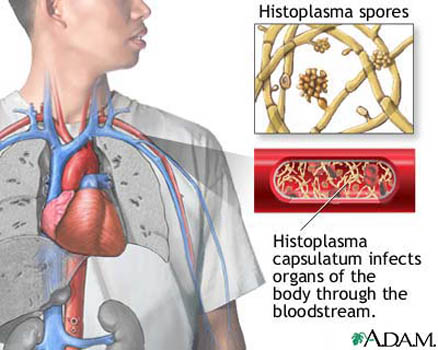Histoplasmosis - diagnosis, symptoms and treatment

What is Histoplasmosis / Histoplasma capsulatum
Histoplasmosis is an illness resulting from INFECTION with the FUNGUS Histoplasma capsulatum. This fungus, commonly called a mold, thrives in soils where bird droppings are abundant, such as chicken farms, barns where pigeons and starlings nest, and caves where bats roost. Histoplasmosis is endemic (continuously present) in the river valley areas of the central United States, where the rich and acidic soil provides an especially supportive environment for fungi to grow.
When inhaled, the H. capsulatum spores cause lesions in the LUNGS. An acute infection causes symptoms only in about 10 percent of people, though nonetheless can do considerable damage to lung tissue. Permanent scarring (granulomas and cavitations) often occurs in untreated histoplasmosis. Chronic histoplasmosis may develop in people who have underlying pulmonary disease or repeated exposure to H. capsulatum spores. The most significant risk of histoplasmosis is disseminated disease, in which the spores enter the BLOOD circulation and migrate to other organs throughout the body. Disseminated histoplasmosis, often an OPPORTUNISTIC INFECTION in people who have HIV/AIDS or are otherwise IMMUNOCOMPROMISED, has a high rate of fatality.
Symptoms of Histoplasmosis and Diagnostic Path
Symptoms in acute histoplasmosis generally appear within two weeks of exposure and include
People who inhale a large quantity of the spores may have extensive lung involvement that causes shortness of breath (DYSPNEA). The diagnostic path begins with a detailed personal health history with emphasis on exposure to bird droppings, blood tests, and a SKIN ANTIGEN test. Chest X-RAY reveals the characteristic histoplasmosis lesions, and may also show enlarged LYMPH nodes in the chest (hilar and mediastinal LYMPHADENOPATHY).
Histoplasmosis Treatment Options and Outlook
Acute histoplasmosis usually resolves without treatment, running a course much like that of a common upper respiratory infection. Bacterial PNEUMONIA may occur as a complication of acute histoplasmosis, requiring treatment with ANTIBIOTIC MEDICATIONS. Doctors prescribe ANTIFUNGAL MEDICATIONS to treat moderate to severe acute symptoms, chronic histoplasmosis, and disseminated histoplasmosis. With appropriate treatment, most people who have normal immunocompetence recover though residual lung damage is possible. Chronic and disseminated forms of infection often require long-term or lifelong treatment with antifungal medications.
| ANTIFUNGAL MEDICATIONS TO TREAT HISTOPLASMOSIS | ||
|---|---|---|
| amphotericin B | itraconazole | ketoconazole |
Risk Factors and Preventive Measures against Histoplasmosis
People who work with live poultry or in outdoor areas that have large bird populations have increased risk for infection with H. capsulatum. Minimizing disturbance of the soil helps reduce the release of spores into the air. People who work in areas where exposure is a risk should wear respirators. Recreational activities in areas where birds or bats are common may also be a risk for exposure.
See also HANTAVIRUS; LESION.